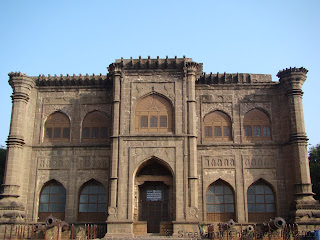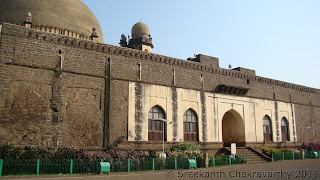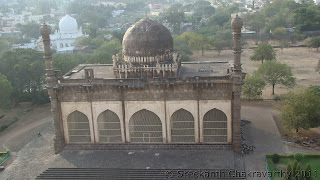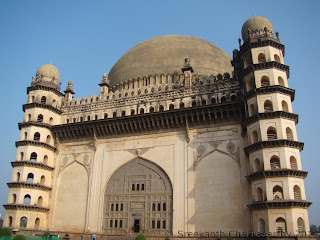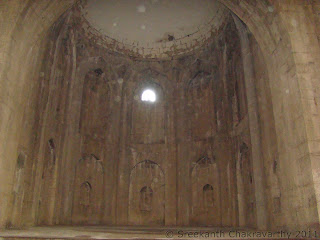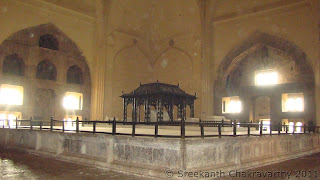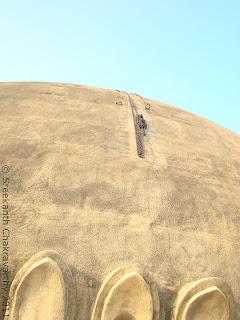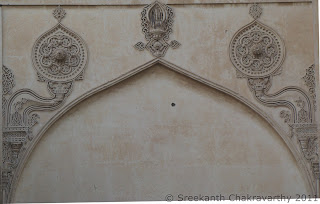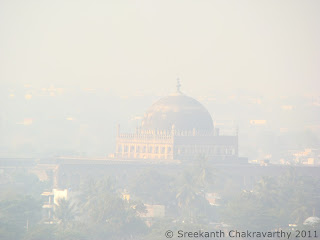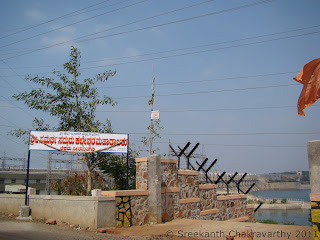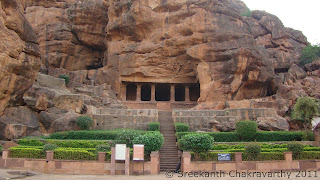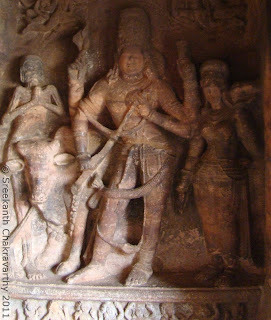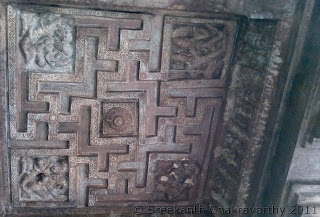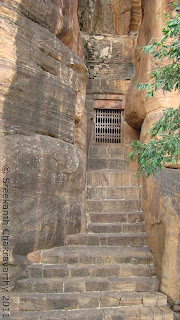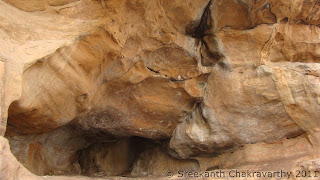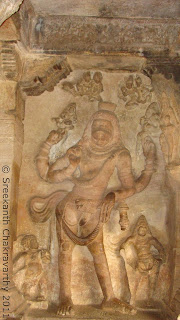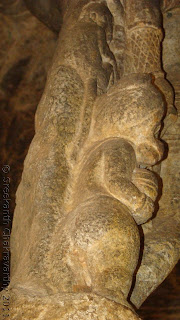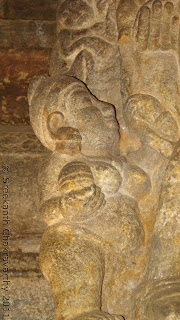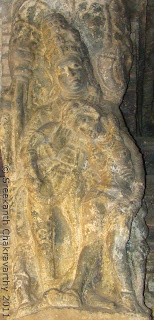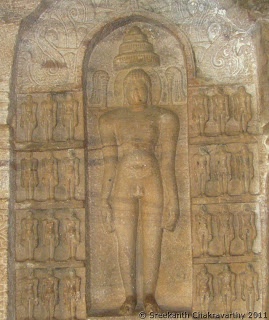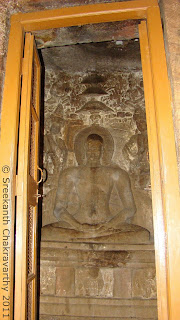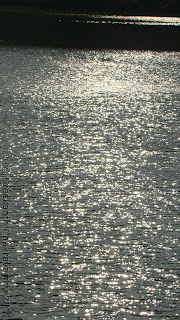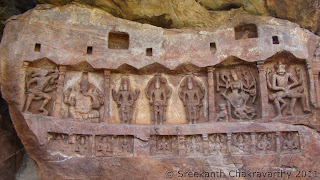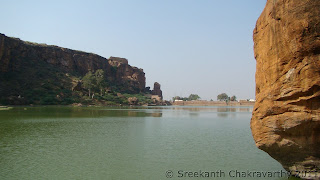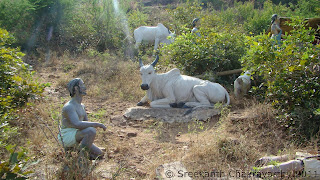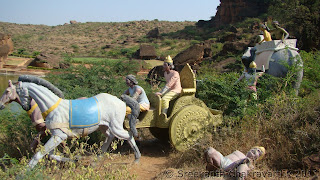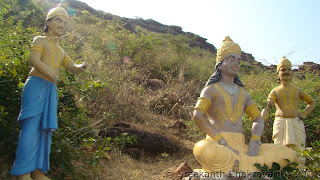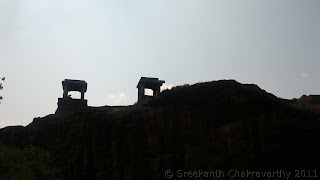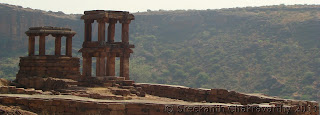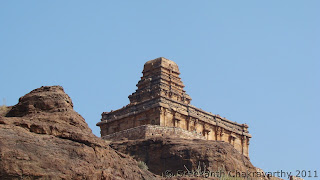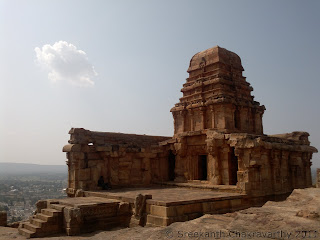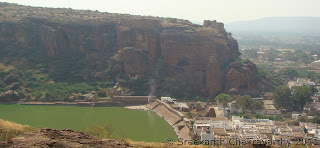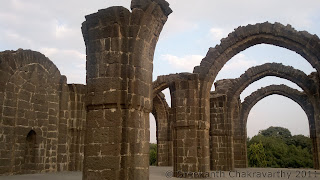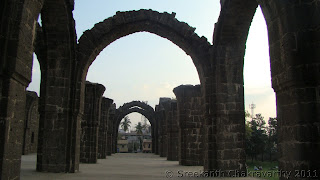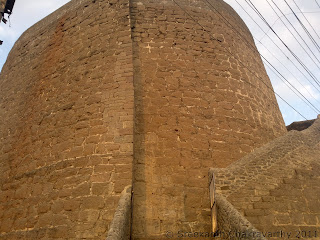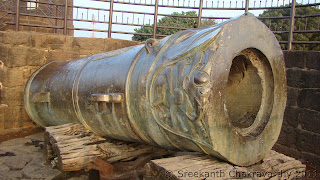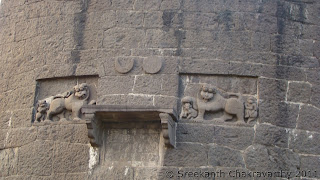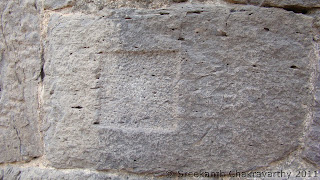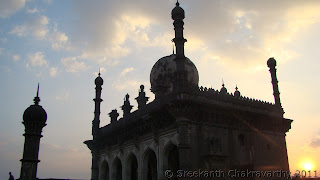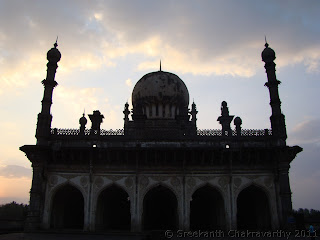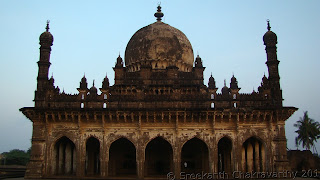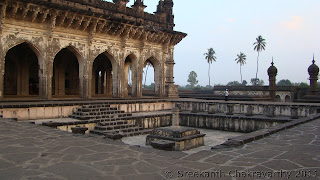Next day morning I was up at 6 a.m. I wanted to be in Gol
Gumbaz before anybody else. But it was pitch dark outside. I had some Badam Milk and asked people
about what other places I can cover that day. Everybody recommended Almatti
Dam, which was an hour's journey from Bijapur. There was a direct train at 9.45
and the railway station was just 10 mins walk from Gol Gumbaz.
Back at room, I got ready and reached Gol Gumbaz by
7.15 a.m.
I was still the first visitor. I took the ticket and walked
up to the Gumbaz. The security guard insisted I get a ticket for the camera and he was no mood to listen to my explanations. I walked back to the
counter and got the camera coupon.
As soon as I entered another security guard approached me. He
offered to explain the significance of this place.
He admitted that he was not a official guide and was ready to accept whatever
money I was ready to pay. I couldn't have asked for anything better. I accepted
with a wide grin on my face. :)
Naqqar Khana and the Guest House
The first building on the way to Gol Gumbaz is the Naqqar Khana, where king's welcome party used to blow trumpets and announce his arrival. This is now converted to museum. The second one is the guest house complex where king's guests used to join him. Not sure what this is now. Finally, you see the gigantic Gol Gumbaz. Next to Gol Gumbaz is the mosque. Keeping in line with the Islamic tradition, a mosque was built next to the tombstone. Though the outer walls of the mosque look good, I was told that it is dilapidated inside and hence the public is not allowed.
The first building on the way to Gol Gumbaz is the Naqqar Khana, where king's welcome party used to blow trumpets and announce his arrival. This is now converted to museum. The second one is the guest house complex where king's guests used to join him. Not sure what this is now. Finally, you see the gigantic Gol Gumbaz. Next to Gol Gumbaz is the mosque. Keeping in line with the Islamic tradition, a mosque was built next to the tombstone. Though the outer walls of the mosque look good, I was told that it is dilapidated inside and hence the public is not allowed.
Naqqar Khana
2nd building
Mosque
Gol Gumbaz
Gol Gumbaz is the mausoleum of Mohammad Adil Shah. He is buried here along with his mistress Rambha Devi (a dancer), wife, and his two children.
Gol Gumbaz
Gol Gumbaz is the mausoleum of Mohammad Adil Shah. He is buried here along with his mistress Rambha Devi (a dancer), wife, and his two children.
The Story
Earlier, this place used to be an entertainment center. The dancers performed in the central hall and the king sat at the rear end (opposite to the entrance). The musicians sat in whispering gallery area so that the music reverberated throughout the hall without any loss of clarity. This was also the place where the king conversed with his wife and mistress. The legend has that once the king casually asked his mistress if she loved him so much and can do anything for him, can she jump down from the gallery. Without a second thought she jumped in. When the crestfallen king asked for her last wish, she expressed her desire to be buried next to him. That's how the tombstones are today. The original graves are a few feet below the tombstones.
Gol Gumbaz
Earlier, this place used to be an entertainment center. The dancers performed in the central hall and the king sat at the rear end (opposite to the entrance). The musicians sat in whispering gallery area so that the music reverberated throughout the hall without any loss of clarity. This was also the place where the king conversed with his wife and mistress. The legend has that once the king casually asked his mistress if she loved him so much and can do anything for him, can she jump down from the gallery. Without a second thought she jumped in. When the crestfallen king asked for her last wish, she expressed her desire to be buried next to him. That's how the tombstones are today. The original graves are a few feet below the tombstones.
Gol Gumbaz
Tombstones
Whispering Gallery
The guide demonstrated how exactly the whispering gallery
works. Camera clicks, footsteps, drop of a coin, and of course the words we speak
(whisper, to be precise), every action we did there echoed 7 times. It was
amazing. I was awestruck, absolutely speechless. Whatever I read in primary school textbook is actually real! Wow!
Whispering Gallery
The chain to the top of the dome -- The tomb was originally
made of stone. The king had a contest where he rewarded people who reached the top of
the tomb using this chain and hoisted a flag.
Parrots whispering outside the gallery ;-)
I was done by 8.15. The guard-cum-guide's duty was in the
dome area that day. Since I still had time for the train, we discussed about
lot of other stuff. He concurred with my decision of visiting Almatti Dam and skipping
Jamia Masjid, Gagan Mahal and couple of other tourist spots. (My decision was
based on my interaction with several people, including the guy manning the
footwear and the auto driver.) He also
showed me the Jod Gumbaz which was the built as a prototype for Gol Gumbaz. I
couldn't take a snap as it was covered with fog.Parrots whispering outside the gallery ;-)
I finally came down at 9.15 a.m., went around the dome
taking snaps. As I was walked towards the exit, I just could not
hide the smile on my face. I was soooooooo happy!
I got into an auto and reached Bijapur Railway Station at 9.40 a.m. The Basava Express reached on time and I was off to my final destination. As usual, I spoke to people in the train. Everybody praised heaps about the dam. I couldn't wait.
Almatti
I reached Almatti about an hour later. I was told that the dam is hardly a kilometer away from the station and the shared autos charge 5 rupees to drop me there. However, couple of auto guys I enquired demanded Rs.100!!! I was shocked. Somebody told me that it is better to walk up to the destination. I saw couple of college kids going in that direction and I followed them.
After an immensely satisfying experience in the morning, I was here for a major disappointment. The point after that "one kilometer" is a place from where I can just see the dam. I started thinking about my options. Can I leave this place now and visit something else? Is there a place nearby or should I go back all the way to Bijapur? I checked with some shopkeepers. They said there is nothing else nearby, but if want to take a closer look at the dam, I should visit Rama -Krishna Park and Lava-Kusha park. I decided to try that out. I remembered that one of my fellow passengers in the train had mentioned that these parks are beautiful as KRS Dam Park in Mysore.
There are no direct autos to those parks. I first had take an auto to the "highway" and from there get into another auto which will drop me at these parks. I reached the highway paying Rs.7. But the auto guy at the highway asked Rs. 70 one-way to the park. I walked out of the auto stand to have my brunch (and plan my next step) at a nearby hotel. The cashier at the restaurant told me that I can take a shared auto going towards Rampur, get down at some circle, and walk a couple of kilometers to reach the park. I thanked him and got into an auto. Fortunately, that auto was going somewhere beyond the park. So I got down at Rama-Krishna park, which was right opposite to the dam entrance. As I walked through the gates I thought of Anil Kumble, a person I always associate with perseverance.
But then, the joy was short-lived. Hardly few steps into the park, I realized that the guy who compared this with KRS park has definitely not seen it. Seriously, even the Basavanagudi Bugle Rock park (in Bangalore) is much bigger and more beautiful than this park. And most importantly, despite it being so close to the dam, I could not view even 60% of the dam gates from the highest point in the park. Colossal waste of time! The caretaker of the park suggested that I visit the Lava Kusha park (a kilometer away) to get a full view of the dam. I thanked him with a smile and walked out. I had enough.
Some pics from the park -
By the time I came out of the park, it was 1 p.m. My return train was at 2.55. So I decided to walk back to the circle from where I can get the autos coming from Rampur. It served dual purposes. One, I could kill some time. Other, I can go to the river side of the dam, get my feet wet, and hopefully get a better view as well.
There was some swamiji's ashram near the power-generation unit of the dam. I wonder why he is not called "Current baba" (I have heard about some Visa baba or Visa god).
I reached the circle at 1.30. The sun was at its peak and all I could find was a stone to sit. An auto came by after almost half an hour and I reached "highway" at 2.15 p.m. Here again my woes continued. The auto guys at the highway asked for Rs.50 to drop me at the railway station. The 2nd option was to wait till he can get 9 more passengers so that it will come down to Rs.5 each. What the...!!! Anyway, since I had time, I decided to wait. By 2.40, we could get 4 more passengers. All of us were heading towards the railway station and agreed to pay Rs.10 each instead of waiting for more passengers.
The train was late by 15 minutes. I reached Bijapur at 4.30 p.m.
While searching for info on Bijapur, I had found out that Ilkal saree is a must buy here. A fellow passenger in the train to Almatti recommended SJ Bhavi and Sangameshwara stores near Gandhi Chowk for this.
I headed straight to these shops from the railway station. I
finished my lunch and shopping and returned to my room at 6.00 p.m. I slept for
a good half an hour and got into the bus at 7 p.m.
As I settled on my favorite window seat in the first row, I started looking back at my day. What a contrasting experience! One moment I was patting my back on my decision to revisit Gol Gumbaz. Few hours later, I was cursing myself for going all the way to Almatti.
But hey wait! It was not over yet. While booking the ticket, I was told that the journey duration to Bangalore was 11 hours in Rajahamsa. But now the conductor bluntly told me that they won't reach before 7.30 a.m. that is, 12.5 hours. "Awesome! What next? Will the bus break down on the way? Bring it on!", I thought.
Well, anyway, no such thing happened and I was back where it all started by 7.30 a.m.
ನೀವೆಲ್ಲಿ ಹೋದರು ಬರಲೇಬೇಕು, ನಮ್ಮೂರಿನಲ್ಲೇ ಬದುಕಲುಬೇಕು, ಪರದೇಶದಲ್ಲಿ ಸ್ಥಳ ನಮಗಿಲ್ಲ, ಹುಟ್ಟಿದ ಊರೇ ನಮಗೆಲ್ಲಾ...
ನೀವೆಲ್ಲಿ ಹೋದರು ಬರಲೇಬೇಕು, ನಮ್ಮೂರಿನಲ್ಲೇ ಬದುಕಲುಬೇಕು, ಪರದೇಶದಲ್ಲಿ ಸ್ಥಳ ನಮಗಿಲ್ಲ, ಹುಟ್ಟಿದ ಊರೇ ನಮಗೆಲ್ಲಾ...
Sidewing:
The security guard at Gol Gumbaz is a post graduate with 92%
score.
The best time to be in Gol Gumbaz is before 7.30 a.m. People start pouring in after that. In summer, they might be in earlier.
The best time to be in Gol Gumbaz is before 7.30 a.m. People start pouring in after that. In summer, they might be in earlier.
"Whisper" in the Whispering Gallery. If you want to shout to hear the echo, go to some hilltop. And yeah, no chorus please.
I bought an Ilkal saree from the Bhavi stores. Their range starts at Rs.550. I liked the Rs.850 saree more than the Rs.3500 saree.
